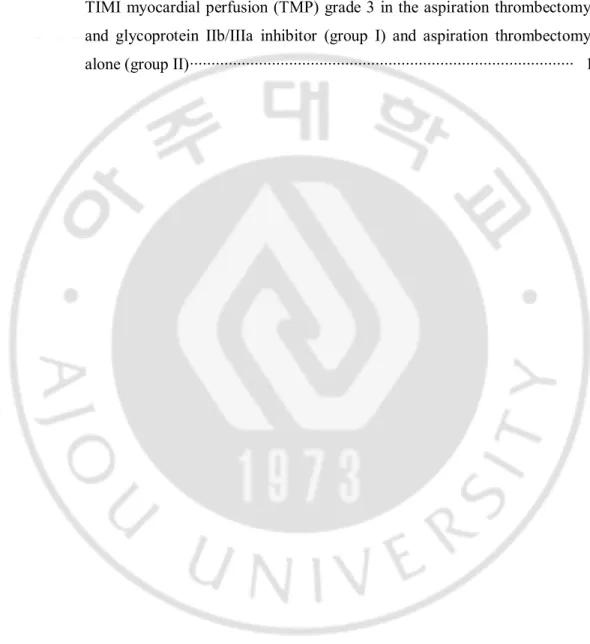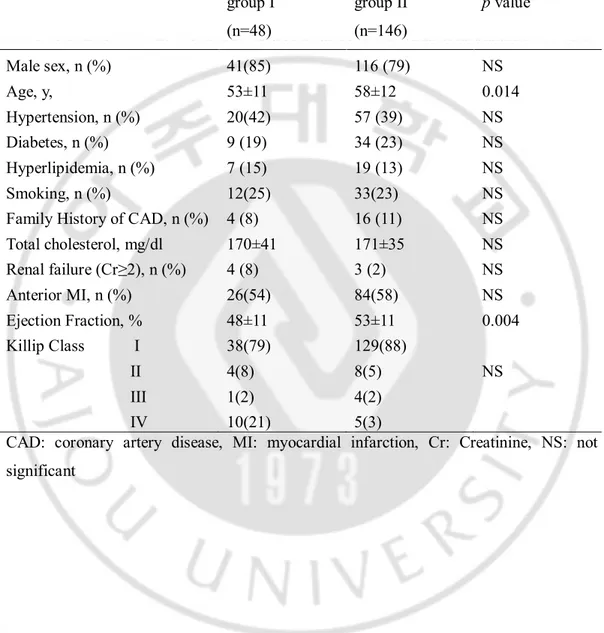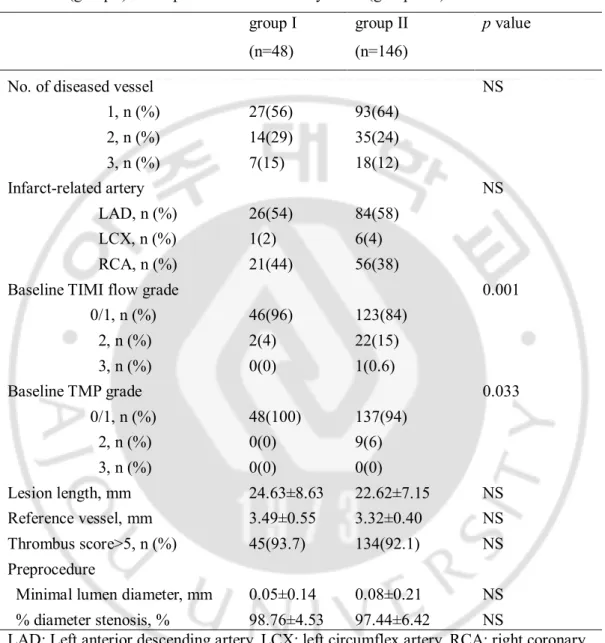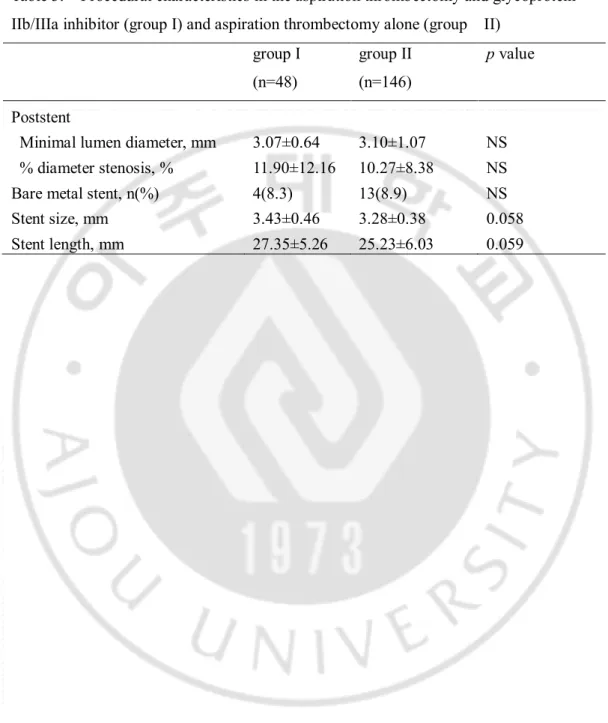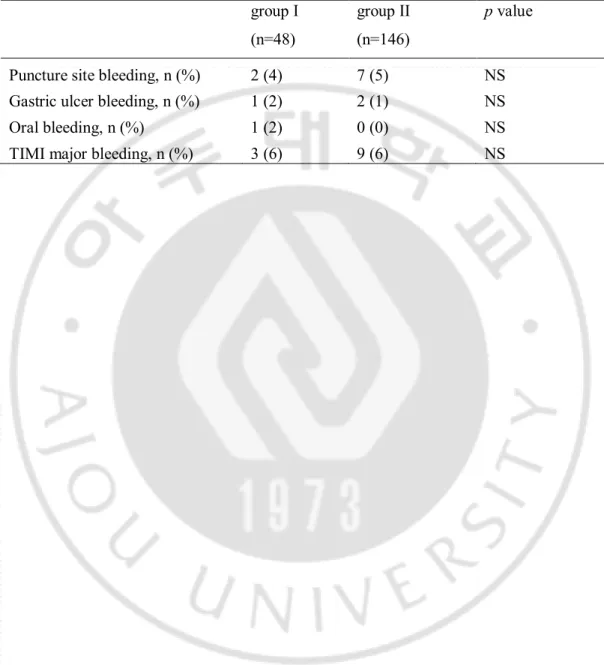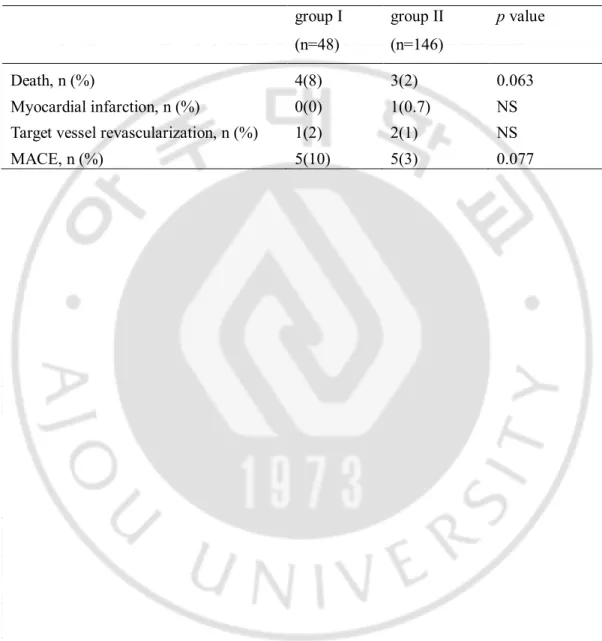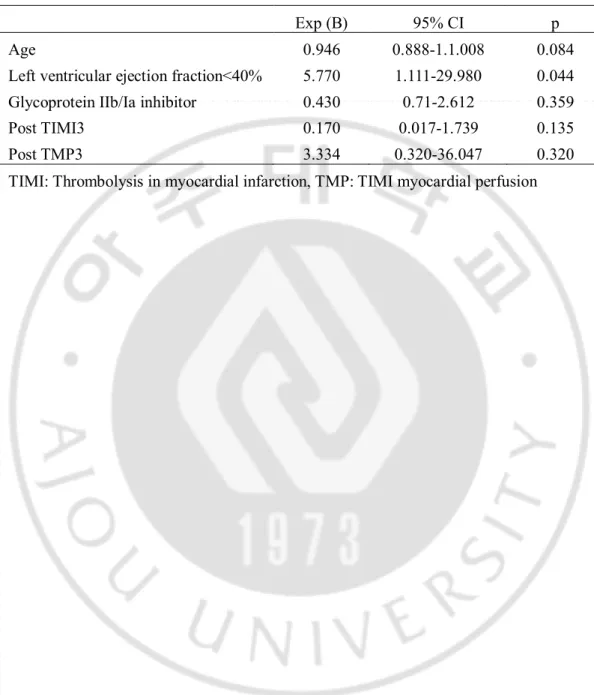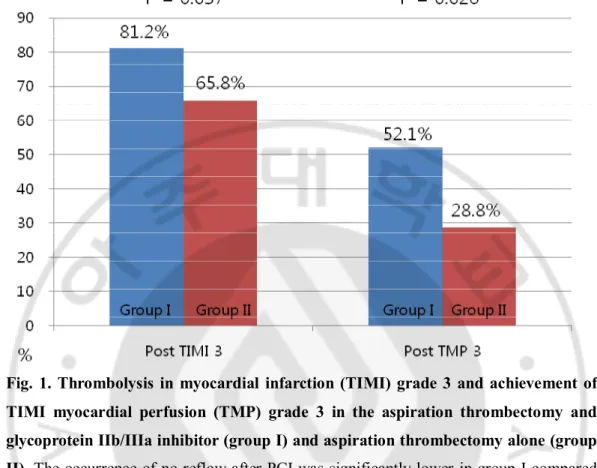의학
석사학위 논문
일차적
경피적 관상동맥
중재술에서
흡입 혈전제거술과
당단백질
IIb/IIIa 수용체 차단제
병합
치료와 흡입 혈전제거술
단독
치료의 비교연구
아
주 대 학 교 대 학 원
의학과
/의학전공
조
대 열
일차적
경피적 관상동맥
중재술에서
흡입 혈전제거술과
당단백질
IIb/IIIa 수용체 차단제
병합
치료와 흡입 혈전제거술
단독
치료의 비교연구
지도교수
탁 승 제
이
논문을 의학 석사학위 논문으로 제출함
.
2012 년 2 월
아
주 대 학 교 대 학 원
의학과
/의학전공
조
대 열
조대열의
의학 석사학위 논문을 인준함.
심사위원장
탁 승 제 인
심사위원
신 준 한 인
심사위원
최 소 연 인
아
주 대 학 교 대 학 원
2011 년 12 월 20 일
i -국문 요약-
일차적
경피적 관상동맥 중재술에서 흡입 혈전제거술과
당단백질
IIb/IIIa 수용체 차단제 병합 치료와
흡입
혈전제거술 단독 치료의 비교연구
목적 : 흡입 혈전제거술과 당단백질 IIb/IIIa 수용체 차단제는 ST 분절 상승을 동반한 급성심근경색 환자의 일차적 중재시술에 있어서 허혈성 합병증을 감소시키고 임상결과를 개선시키는 것으로 알려져 있다. 그러나 흡입 혈전제거술만 시행한 것에 비해 당단백질 IIb/IIIa 수용체 차단제의 추가적 사용이 임상 결과에 미치는 영향에 대해서는 잘 알려진 바가 없다. 이 연구의 목적은 ST 분절 상승을 동반한 급성심근경색 환자의 일차적 중재시술에 있어서 흡입 혈전제거술만 시행한 군과 추가적인 당단백질 IIb/IIIa 수용체 차단제를 사용한 군의 임상 결과를 비교하고자 한다. 재료 및 방법 : 2005 년 11 월부터 2009 년 7 월까지 아주대학교병원에 내원한 ST 분절 상승 급성심근경색 환자 중 일차적 중재술 시 흡입 혈전제거술과 당단백질 IIb/IIIa 수용체 차단제를 같이 사용한 군(I 군, n=48)과 흡입 혈전제거술만 사용한 군(II 군, n=146)을 대상으로 하였다. 주요 심장사건은 사망, 심근경색증의 재발, 표적혈관재관류술로 정의하였고 두 군 간의 임상적소견과 관상동맥조영술에서의 스텐트 시술 전 후 Thrombolysis Inii
Myocardial Infarction (TIMI) 혈류와 TIMI myocardial perfusion (TMP) 등급을
비교하였다. TIMI 혈류 0,1,2 는 no reflow 로, TIMI 혈류 3 는 정상 혈류로
정의하였다. 결과 : 환자의 나이는 II 군에서 더 많았으며(53 ±11 vs. 58 ±12 세, p=0.014), 좌심실구혈율은 I 군 에서 더 낮았다(48±11 vs. 53±11%, p=0.004). 시술 후 no reflow 현상은 I 군 에서 더 적었고(18.8 vs. 34.2%, p=0.037), TMP 등급 3 획득률은 I 군 가 더 많았다(52.1% vs. 28.8%, p=0.026). 사망(8.3% vs. 2.1%, p=0.063), 심근경색의 재발(0.0% vs. 0.7%, p=0.45), 재관류술(2.1% vs. 1.4%, p=0.737)과 1 년 주요 심장 사망은 두 군 간의 차이가 없었다(10.4% vs. 3.4%, p=0.077). 전체 환자에서 주요 심장 사망 발생의 예측인자를 평가하기 위하여 다변량분석을 시행한 결과 낮은 좌심실구혈율(EF <40%)이 유일한 독립적인 예측인자였으며(OR 5.383, 95% CI 1.043-27.782 p=0.044), 당단백 IIb/IIIa 수용체 차단제의 사용은 주요 심장 사망의 예측인자가 아니었다. 결론 : 급성심근경색 환자의 일차적 중재시술 시 흡입 혈전제거술만 사용한 경우에 비하여 추가적인 당단백질 IIb/IIIa 수용체 차단제의 사용은 시술 후 혈류 개선에 도움이 되었으나 장기 임상 결과에 영향을 미치지 않았으며, 주요 심장 사망의 유일한 예측인자는 낮은 좌심실 구혈율이었다.
iii
핵심어 : 일차적 관상동맥 중재술, 흡입 혈전제거술, 당단백질 IIb/IIIa 수용체 차단제
iv
차
례
국문요약 ··· i 차례 ··· iv 표차례 ··· v 그림차례 ··· vi Ⅰ. 서론 ··· 1 Ⅱ. 연구대상 및 방법 ··· 3 A. 대상환자 ··· 3 B. 방법 ··· 3 C. 통계 ··· 4 Ⅲ. 결과 ··· 6 Ⅳ. 고찰 ··· 15 Ⅴ. 결론 ··· 19 참고문헌 ··· 20 Abstract ··· 22v
표
차례
Table 1. Baseline clinical characteristics between patients with aspiration thrombectomy and glycoprotein IIb/IIIa inhibitor (group I) and aspiration thrombectomy alone (group II) ··· 9
Table 2. Angiographic variables in the aspiration thrombectomy and glycoprotein IIb/IIIa inhibitor (group I) and aspiration thrombectomy alone (group II) ··· 10
Table 3. Procedural characteristics in the aspiration thrombectomy and glycoprotein IIb/IIIa inhibitor (group I) and aspiration thrombectomy alone (group II)
··· 11
Table 4. Bleeding complications in the aspiration thrombectomy and glycoprotein IIb/IIIa inhibitor (group I) and aspiration thrombectomy alone (group II)
··· 12
Table 5. Major adverse cardiaic events (MACE) during the 1-year follow-up period in the aspiration thrombectomy and glycoprotein IIb/IIIa inhibitor (group I ) and aspiration thrombectomy alone (group II) ··· 13
Table 6. Multivariate predictors of 1-year major adverse cardiac events
vi
그림
차례
Fig. 1. Thrombolysis in myocardial infarction (TIMI) grade 3 and achievement of TIMI myocardial perfusion (TMP) grade 3 in the aspiration thrombectomy and glycoprotein IIb/IIIa inhibitor (group I) and aspiration thrombectomy alone (group II) ··· 15
- 1 -
I. 서 론
협심증, 심근경색증 등의 허혈성 심장질환은 선진국에서 성인 사망률의 주요한 원인이며, 심근경색증은 미국에서 사망 원인의 1 위를 차지하고 있는 질환이다. 우리나라에서도 급성심근경색증의 유병률은 빠르게 증가하고 있다. ST 분절 상승의 급성심근경색증은 죽상동맥경화판의 파열이나 미란에 의하여 혈관 내 혈전 생성으로 관상동맥 폐쇄가 일정한 시간동안 지속되어 심전도에서 ST 분절의 유의한 상승을 보이는 심근세포가 괴사되는 상태를 말한다. 따라서 ST 분절 상승의 급성심근경색증은 응급 재개통 요법이 필요하며, ST 분절 상승 심근경색증 환자는 증상이 발현된 후 폐쇄된 관상동맥의 혈류가 얼마나 신속히 다시 개통되는가에 따라 예후가 결정된다. 재개통의 방법으로는 일차적 경피적 관상동맥 중재술이나 혈전용해제 투여가 있으나, 최근 ST 분절 상승 급성심근경색 환자에서 혈전용해제의 사용보다 일차적 경피적 관상동맥 중재술이 임상 예후에 있어서 더 우월한 치료 전략임이 알려져 있다. 그러나 심외막 관상동맥의 TIMI 혈류 3 등급을 획득함에도 불구하고 많은 양의 혈전 부하로 인하여 시술 또는 스텐트 삽입 시 발생하는 혈전 또는 경화반 물질들이 말초 혈관 색전을 형성 할 수 있으며, 이차적으로 관상동맥의 원위부 혈류 흐름의 저하나 재관류가 없는 상태를 초래하고, 오히려 경색부위가 확대되기도 한다(Burzotta et al., 2005). 일차적 중재시술 시 발생하는 원위부 혈관 색전에 의한 미세혈관폐쇄는 약- 2 - 15% 정도로 알려져 있으며, 이 환자들은 증가된 경색 부위를 갖고 불량한 예후를 갖는 것으로 조사되었다(Henriques et al., 2002). 이러한 미세혈관폐쇄의 발생을 예방하기 위해 다양한 작동 원리를 가진 기구를 이용한 연구들이 진행되었으나 아직 까지 뚜렷한 결론을 제시하지 못하고 있다. 또한 혈소판 당단백질 IIb/IIIa 수용체 차단제는 혈소판 응집의 최종단계를 차단하는 강력한 혈소판 응집 억제제로 아직 ST 분절 상승을 동반한 급성심근경색 환자의 일차적 중재시술 후 예후에 있어서 논란이 일고 있고, 흡입 혈전제거술과 당단백질 IIb/IIIa 수용체 차단제의 추가적 사용이 임상 결과에 미치는 영향에 대해서는 잘 알려진 바가 없다. 따라서 이 연구에서는 ST 분절 상승을 동반한 급성심근경색 환자의 일차적 중재시술에 있어서 흡입 혈전제거술만 시행한 군과 추가적인 당단백질 IIb/IIIa 수용체 차단제를 사용한 군의 임상 결과를 비교하고자 하였다.
- 3 -
II. 대상 및 방법
A. 대상 환자 2006 년 11 월부터 2009 년 7 월까지 아주대학교 병원에 내원한 ST 분절 상승 급성 심근경색 환자 중 일차적 중재술 시 흡입 혈전제거술과 당단백질 IIb/IIIa 수용체 차단제를 같이 사용한 군(I 군, n=48)과 흡입 혈전제거술만 시행한 군(II 군, n=146)을 대상으로 하였다. 본 연구는 후향적인 연구로, 대상 환자들의 의무기록을 검토하여 두 군간의 임상적 특징과 관상동맥 조영술 소견 및 1 년간 주요 심장사건 및 사망률에 대해서 분석하였다. B. 방법 모든 환자는 경구용 aspirin 300mg 과 clopidogrel 600mg 을 시술 전복용하였고 Heparin 은 60U/kg 을 투여한 다음 시간당 1000U 을 지속적으로
정주하였다. 연구에 사용되어진 Abciximab 은 혈소판 당단백질
IIb/IIIa 수용체를 직접 차단하는 chimeric 단클론성 항체로서 일차적 중재시술
시행 전에 0.25mg/kg 를 주입한 다음 분당 0.125mcg 을 12 시간 동안 정주
하였다. 혈전 흡인을 위하여 Thrombuster catheter(Kaneka Corp, Japan)을
이용하였다. 각 군 간에 환자의 나이, 성별, Killip class, 관상동맥 질환
위험인자로 알려진 고혈압, 당뇨병, 고지혈증, 흡연력, 가족력 등의 위험요인
- 4 - 1 년간 주요 심장사건 및 사망률에 대해서 비교 분석하였다. 또한, 입원 기간 내 시행한 이면성 심초음파 검사에서 좌심실 구혈률을 측정하였다. 24 시간 내에 처음으로 발생한 ST 분절 상승 급성 심근경색증환자를 대상으로 하였으며, ST 분절 상승 급성 심근경색증의 정의는 troponin-I, T 혹은 creatinine kinase-MB 와 같은 심근 효소의 상승 및 허혈의 증상과 더불어 심전도에서 ST 분절의 상승이 관찰된 경우로 하였다. 이 중 심인성 쇼크, 과거 심근경색의 과거력이 있거나 만성 관상동맥 완전폐색, 예측 생존 기간이 1 년 미만, 당단백질 IIb/IIIa 수용체 차단제의 금기 사항 등이 있는 환자는 제외하였다.
관상동맥 조영술에서 혈류의 흐름은 Thrombolysis In Myocardial Infarction
(TIMI) 혈류를 이용하였으며, 원위부가 전혀 조영되지 않을 때를 0, 소량이
조영되나 원위부에 완전히 조영되지 않을 때를 I, 완전히 조영되지만 혈류가
느린 경우를 II, 원위부까지 신속하고 완전하게 조영되고 제거되는 경우를
III 로 정의하였다. TIMI myocardial perfusion (TMP) 등급은 심근에 조영제가
전혀 염색되지 않는 경우를 0, 염색이 없어지지 않고 지속되는 경우를 I,
염색이 천천이 없어지거나 3 회의 심장 주기 후에도 남아있는 경우를 II,
3 회의 심장 주기 후에 없어지는 경우를 III 로 정의하였다. 출혈성 합병증 중
TIMI major bleeding(TIMI 주 출혈)은 두개강 내 출혈이나 후복막 출혈이
보이거나 헤모글로빈 감소가 5g/dl 이상이거나 헤마토크리트 감소가 15%
- 5 -
1 차 연구 종결점으로는 시술 직후 두 군간의 TIMI 혈류 등급과
TMP 등급을 비교하였고 2 차 연구 종결점으로 주요 심장 사건 (major adverse
cardiac events, MACE)은 사망, 심근경색증의 재발, 표적혈관 재관류술로
정의하였다. 사망은 심부전증, 다기관 부전증 등 모든 원인에 의한 사망으로 정의하였다. 모든 혈액검사는 PCI 전의 검사 자료를 활용하였다. C. 통계 ST 분절 상승 급성 심근경색 환자 중 일차적 중재술 시 흡입 혈전제거술과 당단백질 IIb/IIIa 수용체 차단제를 같이 사용한 군과 흡입 혈전제거술만 시행한 군의 임상적 특징과 관상동맥 조영술 소견을 비교하기
위해 Chi-square test, 독립 변수 t-test 를 사용하였고 1 년간 주요심장사건에
대한 예측인자를 알아보기 위해 다변량 회귀분석을 이용하였다. 통계는 SPSS
v11.5 를 이용하여 수행하였으며 p 값이 0.05 이하일 때를 통계적으로
- 6 -
III. 결 과
A. 환자의 임상특성 일차적 중재술 시 I 군의 평균 연령은 53±11세로 II 군의 평균 연령 58±12세보다 더 낮았다. 고혈압은 I 군에서 20명 (42%), II 군에서 57명 (39%)로 양 군간의 차이는 없었다. 당뇨 및 고지혈증의 병력에서도 양 군간의 차이는 없었고, 흡연력은 I 군의 25%에서 있었고 II 군의 23%의 환자가 갖고 있었다. 심혈관 질환의 가족력은 I 군의 8%, II 군의 11%에서 갖고 있었고, 양 군간의 차이는 없었다. 평균 총 콜레스테롤 수치는 각각 170±41mg/dL, 171±35mg/dL 로 두 군간의 차이가 없었다. 좌심실구혈율은 I 군에서 48±11%로 II 군의 53±11%에 비해 유의하게 낮았다(Table 1). B. 관상동맥 조영술 소견 관상동맥 조영술에서 경색 관련 동맥의 종류와 2개 병변 이상의 다혈관 질환의 경우 또한 양 군 간에 유의한 차이가 없었다. TIMI 혈류 등급에서 0 또는 1이 I 군에서 II 군에 비해 46명(96%)으로 높았고, 2를 보이는 경우가 2명(4%)로 II 군에 비해 낮았다. TMP 등급에서 0 또는 1일 보이는 경우가 흡입 I 군에서 100% 였고, II 군에서 94%로, II 군에서 유의하게 낮았다(Table 2). 스텐트 삽입 시 스텐트의 길이, 너비 등은 두 군간에 유의한 차이가- 7 - 18.8%로 II 군의 34.2%에 비해 유의하게 적었고, TMP 등급 3 획득률은 I 군에서 52.1%로 II 군의 28.8%에 비해 유의하게 높았다 (Figure 1). C. 1년 추적 관찰 시 나타난 출혈 합병증과 주요 심장 사건 1년 추적 관찰 시까지 나타난 출혈 합병증을 조사하였다. I 군과 II 군에서 시술 부위 출혈, 위궤양 출혈, 구강 출혈, TIMI 주 출혈의 빈도는 유의한 차이가 없었다(Table 4). 1년 추적 관찰 시 나타난 주요 심장 사건에서, I 군의 사망률 8.3%, II 군의 사망률 2.1%였으며(p=0.063), 심근경색증의 재발(0.0% vs. 0.7%, p=0.45), 재관류술(2.1% vs. 1.4%, p=0.737)로 1년 주요 심장 사건은 두 군 간의 유의한 차이가 없었다(10.4% vs. 3.4%, p=0.077, Table 5). 전체 환자에서 주요 심장 사건 발생의 예측인자를 평가하기 위하여 다변량분석을 시행한 결과 낮은 좌심실구혈율(EF <40%)이 유일한 독립적인 예측인자였으며(OR 5.383, 95% CI 1.043-27.782 p=0.044), 당단백질 IIb/IIIa 수용체 차단제의 사용은 주요 심장 사건 발생의 예측인자는 아니었다(Table 6).
- 8 -
Table 1. Baseline clinical characteristics between patients with aspiration thrombectomy
and glycoprotein IIb/IIIa inhibitor (group I) and aspiration thrombectomy alone (group II)
group I (n=48) group II (n=146) p value Male sex, n (%) 41(85) 116 (79) NS Age, y, 53±11 58±12 0.014 Hypertension, n (%) 20(42) 57 (39) NS Diabetes, n (%) 9 (19) 34 (23) NS Hyperlipidemia, n (%) 7 (15) 19 (13) NS Smoking, n (%) 12(25) 33(23) NS Family History of CAD, n (%) 4 (8) 16 (11) NS Total cholesterol, mg/dl 170±41 171±35 NS Renal failure (Cr≥2), n (%) 4 (8) 3 (2) NS Anterior MI, n (%) 26(54) 84(58) NS Ejection Fraction, % 48±11 53±11 0.004 Killip Class I 38(79) 129(88) II 4(8) 8(5) NS III 1(2) 4(2) IV 10(21) 5(3)
CAD: coronary artery disease, MI: myocardial infarction, Cr: Creatinine, NS: not significant
- 9 -
Table 2. Angiographic variables in the aspiration thrombectomy and glycoprotein IIb/IIIa inhibitor (group I) and aspiration thrombectomy alone (group II)
group I (n=48)
group II (n=146)
p value
No. of diseased vessel NS 1, n (%) 27(56) 93(64) 2, n (%) 14(29) 35(24) 3, n (%) 7(15) 18(12) Infarct-related artery NS LAD, n (%) 26(54) 84(58) LCX, n (%) 1(2) 6(4) RCA, n (%) 21(44) 56(38)
Baseline TIMI flow grade 0.001 0/1, n (%) 46(96) 123(84) 2, n (%) 2(4) 22(15) 3, n (%) 0(0) 1(0.6) Baseline TMP grade 0.033 0/1, n (%) 48(100) 137(94) 2, n (%) 0(0) 9(6) 3, n (%) 0(0) 0(0) Lesion length, mm 24.63±8.63 22.62±7.15 NS Reference vessel, mm 3.49±0.55 3.32±0.40 NS Thrombus score>5, n (%) 45(93.7) 134(92.1) NS Preprocedure
Minimal lumen diameter, mm 0.05±0.14 0.08±0.21 NS % diameter stenosis, % 98.76±4.53 97.44±6.42 NS
LAD: Left anterior descending artery, LCX: left circumflex artery, RCA: right coronary artery, TIMI: thrombolysis in myocardial infarction, TMP: TIMI myocardial perfusion
- 10 -
Table 3. Procedural characteristics in the aspiration thrombectomy and glycoprotein IIb/IIIa inhibitor (group I) and aspiration thrombectomy alone (group II)
group I (n=48) group II (n=146) p value Poststent
Minimal lumen diameter, mm 3.07±0.64 3.10±1.07 NS % diameter stenosis, % 11.90±12.16 10.27±8.38 NS Bare metal stent, n(%) 4(8.3) 13(8.9) NS Stent size, mm 3.43±0.46 3.28±0.38 0.058 Stent length, mm 27.35±5.26 25.23±6.03 0.059
- 11 -
Table 4. Bleeding complications in the aspiration thrombectomy and glycoprotein IIb/IIIa inhibitor (group I) and aspiration thrombectomy alone (group II)
group I (n=48)
group II (n=146)
p value
Puncture site bleeding, n (%) 2 (4) 7 (5) NS Gastric ulcer bleeding, n (%) 1 (2) 2 (1) NS Oral bleeding, n (%) 1 (2) 0 (0) NS TIMI major bleeding, n (%) 3 (6) 9 (6) NS
- 12 -
Table 5. Major adverse cardiaic events (MACE) during the 1-year follow-up period in the aspiration thrombectomy and glycoprotein IIb/IIIa inhibitor (group I) and aspiration thrombectomy alone (group II)
group I (n=48) group II (n=146) p value Death, n (%) 4(8) 3(2) 0.063 Myocardial infarction, n (%) 0(0) 1(0.7) NS Target vessel revascularization, n (%) 1(2) 2(1) NS MACE, n (%) 5(10) 5(3) 0.077
- 13 -
Table 6. Multivariate predictors of 1-year major adverse cardiac events
Exp (B) 95% CI p Age 0.946 0.888-1.1.008 0.084 Left ventricular ejection fraction<40% 5.770 1.111-29.980 0.044 Glycoprotein IIb/Ia inhibitor 0.430 0.71-2.612 0.359 Post TIMI3 0.170 0.017-1.739 0.135 Post TMP3 3.334 0.320-36.047 0.320 TIMI: Thrombolysis in myocardial infarction, TMP: TIMI myocardial perfusion
- 14 -
Fig. 1. Thrombolysis in myocardial infarction (TIMI) grade 3 and achievement of TIMI myocardial perfusion (TMP) grade 3 in the aspiration thrombectomy and glycoprotein IIb/IIIa inhibitor (group I) and aspiration thrombectomy alone (group II). The occurrence of no-reflow after PCI was significantly lower in group I compared
with group II (18.8% vs 34.2%, p=0.037). The achievement of TMP grade 3 after PCI was significantly higher in group I(52.1% vs 28.8%, p=0.026).
- 15 -
IV. 고 찰
ST 분절 상승 급성 심근경색 환자의 치료에 있어서 일차적 관동맥 중재술은 혈전 용해술에 비하여 재경색, 뇌졸중, 사망의 발생이 더 낮은 것으로 알려져 있는데(Weaver et al., 1997), 이는 일차적 관동맥 중재술 후 정상 심외막 관동맥 혈류(TIMI 3 flow) 획득률이 약 90%로 혈전 용해술의50-60%에 비하여 높기 때문이다(Brener et al., 1998, Stone et al., 2001). 그러나
일차적 관동맥 중재술 후 정상 심외막 관동맥 혈류(TIMI 3 flow)를 보임에도
불구하고 약 30-50%의 환자만 정상 심근 관류를 보이고, 지속적으로 심근
관류 장애를 보이는 환자들은 더 나쁜 임상 예후를 보이는 것으로 알려져
있다(Ito et al., 1996, Costantini et al., 2004). 이러한 심근 경색 환자에서 재개통
후에 보일 수 있는 심근 관류 장애의 원인으로는 심근의 부종, 미세혈관의
연축, 미세혈전에 의한 원위부 색전, 재관류 손상 등이 있고(De Lemos et al.,
2000) 각각의 기전에 따른 치료 및 예방을 위하여 많은 연구가 계속되고 있다
(De Luca et al., 2005, Sardella et al., 2009, Vlaar et al., 2008).
급성 심근 경색 환자의 관상동맥 내 발생하는 혈전은 혈소판이 풍부한
white thrombus 이고, 시간의 경과함에 따라 피브린이 침착되어 red thrombus 로
변하게 된다. 혈소판 당단백질 IIb/IIIa 수용체 차단제는 혈소판 응집의 마지막
단계를 차단하는 현재까지 알려진 가장 강력한 혈소판 응집 억제제이다. 이
중 Abciximab 은 인간 쥐 단일항체 구조물로 다른 혈소판 당단백 차단제보다
- 16 -
15 일까지 지속되는 장점이 있다. 또 저분자량의 당단백질 IIb/IIIa 수용체
차단제와 달리 평활근 세포, 내피세포, 혈소판 등에 존재하는 vitronectin
수용체에 친화력을 갖는데 이러한 vitronectin 수용체의 차단은 급성 혈관 손상
후에 평활근 세포의 이동과 증식을 억제하여 재협착을 예방할 수 있는
것으로 보고되고 있다(Frishman et al., 1995, Reverter et al., 1996). 초기 연구에
따르면 Abciximab 을 통한 혈소판 당단백질 IIb/IIIa 수용체의 차단은 허혈성 합병증의 감소, 단기간의 임상 결과 호전을 보여 주었으나, ST 분절 상승 급성 심근 경색 환자에게 600mg 의 clopidogrel 투약이 정립된 후로 다른 무작위, 이중맹검, 전향적 연구에서 혈소판 당단백질 IIb/IIIa 수용체 차단제를 투약하지 않는 군과 비교하여 장기적으로 임상 결과를 개선시키지 못하였다 (Schulz et al., 2010). 원위부 혈관으로의 혈전의 양을 줄여 원위부 색전을 줄이는 기계적인 방법으로 흡입 혈전제거술과 원위부 보호 필터를 사용하는 방법이 있다. 원위부 보호 필터의 경우 일차적 관상동맥 중재술을 시행 받는 환자에 있어서 사용하지 않는 군과 비교하여 임상 예후에 별다른 영향을 주지 못하였다 (Tahk et al., 2008). 흡입 혈전제거술은 ST 분절 상승을 동반한 급성심근경색 환자의 일차적 중재시술에 있어서 심근 관류를 증가시키고 ST 분절의 더 빠른 회복에 영향을 주는 것으로 알려져 있다 (Galiuto et al.,
2006, Silva-Orrego et al., 2006). TAPAS 연구에 따르면 흡입 혈전제거술을
- 17 - Minneapolis, MN)를 이용한 흡입 혈전제거술은 통계적으로 유의하게 사망, 심근경색의 발생을 감소시켰다(5.6% vs 9.9%, P=.009). 그러나 다른 다기관, 무작위, 전향적 연구에서는 TAPAS 연구에서의 흡입 혈전제거술의 효과를 뚜렷하게 도출하지 못하고 있고 흡입 혈전제거술만 시행한 것에 비해 당단백질 IIb/IIIa 수용체 차단제의 추가적 사용이 임상 결과에 미치는 영향에 대해서는 잘 알려진 바가 없다. 본 연구에서는 ST 분절 상승을 동반한 급성심근경색 환자의 일차적 중재시술에 있어서 흡입 혈전제거술만 시행한 군과 추가적인 당단백질 IIb/IIIa 수용체 차단제를 사용한 군의 시술 후 관상동맥 조영술 결과를 비교하였고 이후 1 년간 주요 심장 사건을 비교하고자 하였다. 시술 후 no reflow 현상은 추가적인 당단백질 IIb/IIIa 수용체 차단제를 사용한 군에서 더 적었고 TMP 등급 3 획득률은 추가적인 당단백질 IIb/IIIa 수용체 차단제를 사용한 군에서 더 많았다. 그러나 사망, 심근경색의 재발, 재관류술과 1 년 주요 심장 사망은 두 군 간의 차이가 없었다. 즉, 단기적으로 혈류를 개선 시키기는 하였으나, 장기적으로 생존률에는 영향을 미치지 못하였다고 추측할 수 있겠고 1 년간 주요 심장 사망의 유일한 예측인자는 낮은 좌심실 구혈율( < 40%)이었다. 1 년 추적 관찰 시 나타난 출혈 합병증에서는, 흡입 혈전제거술과 당단백질 IIb/IIIa 수용체 차단제 사용군과 혈전제거술만 시행한 군에서 시술 부위 출혈, 위궤양 출혈, 구강 출혈, TIMI 주 출혈의 빈도는 유의한 차이가
- 18 - 없어, 급성심근경색 환자에서 출혈 합병증을 크게 증가시키지는 않아, 비교적 당단백질 IIb/IIIa 를 안전하게 쓸 수 있을 것으로 사료된다. 본 연구의 제한점으로는 후향적인 연구방법에 따른 결과 변수와 원인 변수 간에 인과관계가 확실하지 않다는 단점이 있고, 자료 수집 과정에서 누락된 요소가 있을 가능성이 있다. 고령일수록 뇌졸중의 병력이나 위장관 출혈의 위험도가 높아 II 군 환자들의 나이가 통계적으로 유의하게 많았을 것으로 보인다. 또한 일차적 관상동맥 중재술을 시행 시 추가 혈소판 당단백질 IIb/IIIa 수용체 차단제 사용을 무작위화 하지 않았으므로 발생하는 선택 오차가 있을 가능성 또한 있다. 따라서 이러한 제한점을 극복하기 위해 앞으로 대규모의 전향적 무작위화 연구를 통한 확인이 필요할 것을 사료된다.
- 19 -
V. 결 론
급성심근경색 환자의 일차적 중재시술 시 흡입 혈전제거술만 사용한 경우에 비하여 추가적인 당단백질 IIb/IIIa 수용체 차단제의 사용은 시술 후 혈류 개선에 도움이 되었으나 장기 임상 결과에 영향을 미치지 않았으며, 주요 심장 사건의 유일한 예측인자는 낮은 좌심실 구혈율이었다.- 20 -
참고문헌
1. Boersma E, Harrington RA, Moliterno DJ, White H, Théroux P, Van de Werf F, de Torbal A, Armstrong PW, Wallentin LC, Wilcox RG, Simes J, Califf RM, Topol EJ, Simoons ML: Platelet glycoprotein IIb/IIIa inhibitors in acute coronary syndromes: a meta-analysis of all major randomised clinical trials. Lancet 359:189-198, 2002
2. Brener SJ, Barr LA, Burchenal JE, Katz S, George BS, Jones AA, Cohen ED, Gainey PC, White HJ, Cheek HB, Moses JW, Moliterno DJ, Effron MB, Topol EJ: Randomized, placebo-controlled trial of platelet glycoprotein IIb/IIIa blockade with primary angioplasty for acute myocardial infarction: Reopro primary PTCA organization and randomized trial (RAPPORT) investigators. Circulation 98: 734-741, 1998
3. Burzotta F, Trani C, Romagnoli E, Mazzari MA, Rebuzzi AG, De Vita M, Garramone B, Giannico F, Niccoli G, Biondi-Zoccai GG, Schiavoni G, Mongiardo R, Crea F: Manual thrombus-aspiration improves myocardial reperfusion: the randomized evaluation of the effect of mechanical reduction of distal embolization by thrombus-aspiration in primary and rescue angioplasty (REMEDIA) trial. J Am Coll Cardiol 46: 371-376, 2005
4. Costantini CO, Stone GW, Mehran R, Aymong E, Grines CL, Cox DA, Stuckey T, Turco M, Gersh BJ, Tcheng JE, Garcia E, Griffin JJ, Guagliumi G, Leon MB, Lansky AJ: Frequency, correlates, and clinical implications of myocardial perfusion after primary angioplasty and stentin, with and without glycoprotein IIb/IIIa inhibition, in acute myocardial infarction. J Am Coll Cardiol 44: 305-312, 2004
5. De Lemos JA, Antman EM, Gibson CM, McCabe CH, Giugliano RP, Murphy SA, Coulter SA, Anderson K, Scherer J, Frey MJ, Van Der Wieken R, Van De Werf F, Braunwald E: Abciximab improves both epicardial flow nd myocardial reperfusion in ST-elevation myocardial infarction. Circulation 101: 239-243, 2000
6. De Luca G, Suryapranata H, Stone GW, Antoniucci D, Tcheng JE, Neumann FJ, Van de Werf F, Antman EM, Topol EJ: Abciximab as adjunctive therapy to reperfusion in acute ST-segment elevation myocardial infarction: a meta-analysis of randomized trials.
- 21 -
JAMA 293: 1759-1765, 2005
7. Frishman WH, Burns B, Atac B, Alturk N, Altajar B, Lerrick K: Novel antiplatelet therapies for treatment of patients with ischemic heart disease: inhibitors of the platelet glycoprotein IIb/IIIa integrin receptor. Am Heart J 130: 877-892, 1995
8. Galiuto L, Garramone B, Burzotta F, Lombardo A, Barchetta S, Rebuzzi AG, Crea F; REMEDIA Investigators: Thrombus aspiration reduces microvascular obstruction after primary coronary intervention: a myocardial contrast echocardiograpy sub-study of the REMEDIA trial. J Am Coll Cardiol 48: 1355-1360, 2006
9. Henriques JP, Zijlstra F, Ottervanger JP, de Boer MJ, van 't Hof AW, Hoorntje JC, Suryapranata H: Incidence and clinical significance of distal embolization during primary angioplasty for acute myocardial infarction. Eur Heart J 23: 1112-1117, 2002 10. Investigators CCEFATiURa: Randomised placebo-controlled trial of abciximab before
and during coronary intervention in refractory unstable angina: the CAPTURE Study.
Lancet 349: 1429-1435, 1997
11. Investigators E: Randomised placebo-controlled and balloon-angioplasty-controlled trial to assess safety of coronary stenting with use of platelet glycoprotein-IIb/IIIa blockade.
Lancet 352: 87-92, 1998
12. Ito H, Okamura A, Iwakura K, Masuyama T, Hori M, Takiuchi S, Negoro S, Nakatsuchi Y, Taniyama Y, Higashino Y, Fujii K, Minamino T: Myocardial perfusion patterns related to thrombolysis in myocardial infarction perfusion grades after coronary angioplasty in patients wih acute anterior myocardial infarction. Circulation 93: 1993-1999, 1996 13. Keeley EC, Boura JA, Grines CL: Primary angioplasty versus intravenous thrombolytic
therapy for acute myocardial infarction: a quantitative review of 23 randomised trials.
Lancet 361: 13-20, 2003
14. Lam JY, Chesebro JH, Steele PM, Dewanjee MK, Badimon L, Fuster V: Deep arterial injury during experimental angioplasty: relation to a positive indium-111-labeled platelet scintigram, quantitative platelet deposition and mural thrombosis. J Am Coll Cardiol 8: 1380-1386, 1986
- 22 -
15. Lincoff AM, Popma JJ, Ellis SG, Hacker JA, Topol EJ: Abrupt vessel closure complicating coronary angioplasty: clinical, angiographic and therapeutic profile. J Am
Coll Cardiol 19: 926-935, 1992
16. Margheri M, Vittori G, Chechi T, Falchetti E, Cosgrave J, Spaziani G, Ricceri I, Giglioli C, Valente S, Gensini GF: Thrombus aspiration with export catheter in ST elevation myocardial infarction. J Interv Cardiol 20: 38-43, 2007
17. Neumann FJ, Blasini R, Schmitt C, Alt E, Dirschinger J, Gawaz M, Kastrati A, Schömig A: Effect of glycoprotein IIb/IIIa receptor blockade on recovery of coronary flow and left ventricular function after the placement of coronary-artery stents in acute myocardial infarction. Circulation 98: 2695-2701, 1998
18. Reverter JC, Beguin S, Kessels H, Kumar R, Hemker HC, Coller BS: Inhibition of platelet-mediated, tissue factor-induced thrombin generation by the mouse/human chimeric 7E3 antibody. Potential implications for the effect of c7E3 Fab treatment on acute thrombosis and "clinical restenosis". J Clin Invest 98: 863-874, 1996
19. Sardella G, Mancone M, Bucciarelli-Ducci C, Agati L, Scardala R, Carbone I, Francone M, Di Roma A, Benedetti G, Conti G, Fedele F: Thrombus aspiration during primary percutaneous coronary intervention improves myocardial reperfusion and reduces infarct size: the EXPIRA (thrombectomy with export catheter in infarct-related artery during primary percutaneous coronary intervention) prospective, randomized trial. J Am Coll
Cardiol 53: 309-315, 2009
20. Schomig A, Kastrati A, Dirschinger J, Mehilli J, Schricke U, Pache J, Martinoff S, Neumann FJ, Schwaiger M: Coronary stenting plus platelet glycoprotein IIb/IIIa blockade compared with tissue plasminogen activator in acute myocardial infarction. Stent versus Thrombolysis for Occluded Coronary Arteries in Patients with Acute Myocardial Infarction Study Investigators. N Engl J Med 343: 385-391, 2000
21. Schulz S, Birkmeier KA, Ndrepepa G, Moshage W, Dotzer F, Huber K, Dirschinger J, Seyfarth M, Schömig A, Kastrati A, Mehilli J: One-year clinical outcomes with abcximab in acute myocardial infarction: result of the BRAVE-3 randomized trial. Clin
- 23 -
Res Cardiol 99: 795-802, 2010
22. Silva-Orrego P, Colombo P, Bigi R, Gregori D, Delgado A, Salvade P, Oreglia J, Orrico P, de Biase A, Piccalò G, Bossi I, Klugmann S: Thrombus aspiration before primary angioplasty improves myocardial reperfusion in acute myocardial infarction: the DEAR-MI (Dethrombosis to Enhance Acute Reperfusion in Myocardial Infarction) study. J Am
Coll Cardiol 48: 1552-1559, 2006
23. Stone GW, Grines CL, Cox DA, Garcia E, Tcheng JE, Griffin JJ, Guagliumi G, Stuckey T, Turco M, Carroll JD, Rutherford BD, Lansky AJ: Comparison of angioplasty with stenting, with or without abciximab, in acute myocardial infarction. N Engl J Med 346: 957-966, 2002
24. Stone GW, Grines CL, Cox DA, Stuckey T, Cohen DJ, Tcheng JE, Garcia E, Guagliumi G, Iwaoka RS, Fahy M, Turco M, Lansky AJ, Griffin JJ, Mehran R: A prospective, multicenter, international randomized trial comparing four reperfusion strategies in acute myocardial infarction: priciple report of the controlled abciximab and device investigation to lower late angioplasty complications (CADILLAC) trial. J Am Coll
Cardiol 37: 648A , 2001
25. Tahk SJ, Choi BJ, Choi SY, Yoon MH, Gwon HC, Hong GR, Kim YJ, Hur SH, Kim KB, Koo BK, Lee SH, Yoon J: Distal protection device protects microvascular integrity during primary percutaneous intervention in acute myocardial infarction: a prospective, randomized, multicenter trial. Int J Cardiol 123: 162-168, 2008
26. Vlaar PJ, Svilaas T, van der Horst IC, Diercks GF, de Smet BJ, van den Heuvel AF, Anthonio RL, Jessurun GA, Tan ES, Suurmeijer AJ, Zijlstra F: Cardiac death and reinfarction after in acute myocardial infarction Study (TAPAS): a 1-year follow up study. Lancet 371: 1915-1920, 2008
27. Weaver WD, Simes RJ, Betriu A, Grines CL, Zijlstra F, Garcia E, Grinfeld L, Gibbons RJ, Ribeiro EE, DeWood MA, Ribichini F: Comparison of primary coronary angioplasty and intravenous thrombolytic therapy for acute myocardial infarction. A quantative review. JAMA 278: 2093-2098, 1997
- 24 - -ABSTRACT-
Comparison of Aspiration Thrombectomy with Glycoprotein
IIb/IIIa Inhibitor versus Aspiration Thrombectomy Alone in
Primary Percutaneous Coronary Intervention
Dai-Yeol Joe
Department of Medical Sciences The Graduate School, Ajou University
(Supervised by Professor Seung-Jae Tahk)
Backgrounds: Recently it has been reported the aspiration thrombectomy improves
clinical outcome and reduces ischemic complications after percutaneous coronary
intervention (PCI) in patients with STEMI. However there was a few of information
about the efficacy of glycoprotein IIb/IIIa inhibitor (GPI) added on aspiration
thrombectomy in dual antiplatelets area. The aim of this study was to compare final
angiographic findings and clinical outcomes between aspiration thrombectomy with GPI
and aspiration thrombectomy alone after PCI in STEMI patients.
Material and methods: This retrospective single center study included 48 STEMI
patients treated with thrombus aspiration catheter and GPI (group I) and 146 STEMI
patients treated with thrombus aspiration catheter alone (group II) during primary PCI
- 25 -
and after PCI and clinical outcomes defined by major adverse cardiovascular event
(MACE; composite of death, myocardial infarction (MI), target vessel revascularization
(TVR)) during 1 years between group I and group II.
Results: The mean age (53 ± 11 years vs 58 ± 12 years, p=0.014) left ventricular ejection
fraction (LVEF) (48 ± 11 % vs 53 ± 11 %, p=0.004) were lower in group I vs group II.
The occurrence of no-reflow after PCI was significantly lower in group I compared with
group II (19% vs 34%, p=0.037). The achievement of TMP grade 3 after PCI was
significantly higher in group I (52% vs 29%, p=0.026). There are no differences of the
rate of death, MI, TVR and total MACE during 1 year after PCI between two groups. By
multivariate analysis low LVEF (EF < 40%) was the only independent predictor for
MACE in all patients (OR 5.383, 95% CI 1.043-27.782 p=0.044) but not additional GPI
use.
Conclusion: Additional use of GPI to aspiration thrombectomy during primary PCI in
STEMI patients leaded to better myocardial flow and perfusion but not improved
long-term clinical outcome.
Key words : Primary percutaneous coronary intervention, aspiration thrombectomy,
